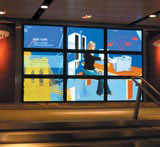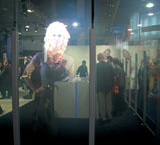What’s in store?

After years of stagnation, in-store environments are evolving to provide futuristic, interactive consumer experiences, with mobile phone stores leading the way. But it’s not only technology retailers that could benefit from this approach, says Trish Lorenz
Life has become a lot more involving over the past ten years. Today we can interact, personalise and play around with just about everything, from voting through the TV set, chatting with people from around the world on-line, taking pictures with a mobile phone and zapping them off to whoever we please.
So why is shopping still exactly the same as it was two decades ago? Yes, in-store environments have been updated to reflect fashions in interiors, but the overall brand experience has been relatively constant – you browse, choose and buy, surrounded by little more than print marketing material and background music.
Vivid Brand retail director Paul King believes it is, in part, due to difficult trading conditions – budgets across all disciplines have been slashed – but admits it can also be attributed to uncertainty and caution. ‘Retailers are waiting for someone else to make a success of technological innovation,’ he says.
And Imagination design director Damian Ferrar, who has recently completed a project to deliver an interactive in-store environment for O2’s six UK flagships, says designers must also shoulder some of the responsibility. ‘We’ve been using interactive solutions in the exhibition world for ages, but not many retail design groups have interactive elements to their business, which means these types of solutions aren’t proposed to retailers at the design stage,’ he says. But, he adds, this is starting to change and at the vanguard of that change are mobile phone retailers.
One of the most interesting projects in the sector is Digit’s work on the ‘experience and engagement’ elements of Motorola’s flagship stores. The first has opened in Chicago, another is due to open in the Far East and a global roll-out is planned.
Digit’s work includes a series of holographic ‘characters’ that populate store windows and are triggered by motion sensors. As customers walk past the window, a character comes towards them and invites them into the store.
‘Store windows are essentially dead space, particularly in the mobile phone industry,’ says Digit senior producer Justin Vir. ‘This window draws people into the store and captures their imagination.’

Within the store, products are grouped by themes, such as music or gaming, and the focus is on interaction – users can download music to phones or take pictures and then print them, for example – rather than simply supplying product information.
‘The whole ethos is to move away from the traditional store, which is all about products on shelves – moving away from display and towards enjoyment,’ says Vir.
Nokia is also redesigning its flagship stores, working with Tomato on the project – a trial store in Moscow is now complete and an international roll-out is about to begin. One of the new elements in the store is a series of LCD screens, known as the Interactive Video Grid, which cover the entire back wall of the store.
Customers are invited to take five-second clips of themselves with cameras available in-store. The clips are projected on to the IVG and, as the global roll-out continues, each store will have images of people shopping in other locations around the world, creating a real-time global community.
On the O2 stores project, Imagination is also moving towards screen-based solutions. The group has removed all print material from store windows, replacing it with LCD tube screens, called Versatubes. Effectively a low resolution screen, windows are now linked to a content management system that staff can access, meaning that content in the windows can be updated as regularly as needed.
Plasma screens have also been installed at the rear of the store and are linked to invisible light beams hidden in the ceiling. As customers break the light beams, they influence the content on the screen, creating ‘abstract, simple and playful’ images.
‘The aim of all this technology is to allow customers to build a relationship with the brand through the store experience, as much as through the product they’re buying,’ says Ferrar.
Vir believes this will be an increasingly important consideration in the future. ‘Technology is improving, costs are going down and more and more retailers are reappraising the importance of engaging with the customer in a retail space,’ he says.
The challenge for designers, says Ferrar, lies in identifying solutions that deliver a return on investment. ‘It’s more difficult to demonstrate return on investment in beautiful abstract pieces, than in solutions that marry to database and loyalty cards,’ he maintains.
He points to the group’s work with Samsung in the US, which has seen it introduce ‘digital briefcases’ to the manufacturer’s New York showroom. Customers can opt to use a Radio Frequency Identification tag to swipe against products they are interested in.
The tag transfers information on all the products the customer has swiped to a personalised page on the store’s website, eliminating the need for pamphlets and brochures.

And there’s no reason to assume technology retailers are the only ones that can benefit from this type of approach. RFID-style technology could be employed by fashion retailers, says Ferrar, to help customers keep a record of their purchases and allow the store to contact clients when a new item, that matches previous purchases, is in stock.
Imagination is also working with a fashion chain in the US, trialling concepts such as a changing room where customers can alter the background – to a beach scene or nightclub for example – to reflect the environment in which clothes are worn.
The technological possibilities clearly exist. What’s needed now is a commitment by retailers to consider how in-store branding and marketing could be enhanced with a judicious use of technology and some creative thinking on the part of retail designers to help clients identify the right opportunities. l
-
Post a comment



